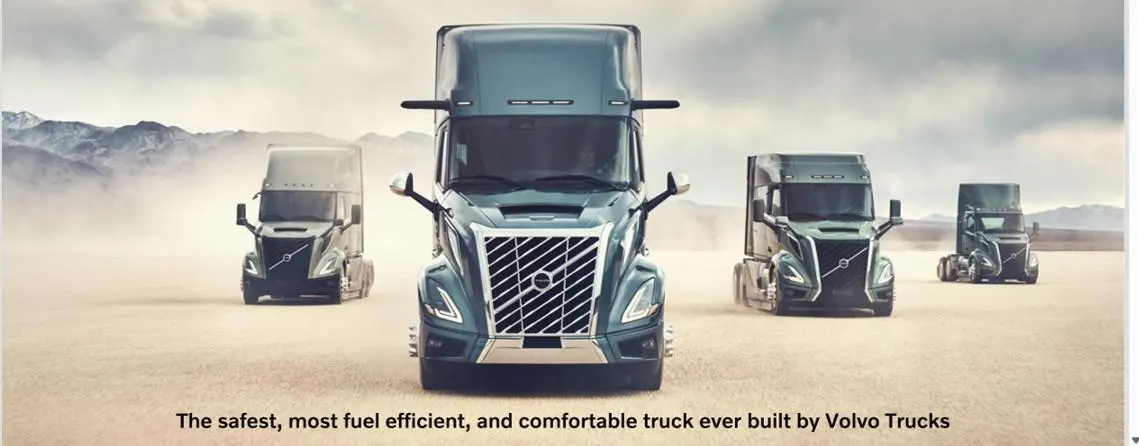By Contributor,Steve Banker
Copyright forbes

The All-New Volvo VNL
Volvo Trucks North America
Volvo Trucks North America’s legacy long-haul truck was built on a platform that has been in use since 1996. Volvo’s new long-haul Class 8 – the VNL – was announced last year and started production in October. This week, Volvo Trucks invited several journalists who cover transportation to the Michelin Laurens Proving Grounds in South Carolina. Here we were able to test drive the truck in controlled conditions and spend the night in the cab. Volvo’s brand is synonymous with safety, and the new truck provides for significant gains in fuel efficiency. But, Volvo wanted to demonstrate that the new truck also delivers a substantial improvement in driver comfort.
Driver Comfort is Important for Driver Retention
Driver turnover exceeds 80% annually, Magnus Koeck, the vice president of strategy, marketing, and brand management at Volvo Trucks, told the assembled journalists. “And this is actually an improvement! A few years ago, it was over 100% turnover per year.” Fleets also spend an average of $10,000 per year to onboard a new driver, a statistic that Mr. Koeck believes underestimates the actual costs. A comfortable driving environment can help fleets attract new drivers and retain the drivers they have.
R&D conducted thousands of driver interviews. What drivers value the most, they determined, is visibility, seat comfort, climate control, a comfortable bunk, a roomy interior, and plenty of storage space.
The VNL delivers on all counts. In terms of visibility, the new camera monitoring system offers superior visibility compared to the mirrors on the side of the truck. The vertical monitors are positioned between the pillar that supports the windshield and the door. Infra-red technology creates better visibility at night. There are reference lines that indicate the rear of the trailer. Cameras track the trailer’s rear corners, providing visibility into how close the trailer is approaching the side of the road during tighter turns.
On my test drives, I found the monitors to be superior to the side mirrors. There was barely any blind spot at all. By the end of the drive, I was ignoring the mirrors and was focusing solely on the monitors. I asked Maddie Sullivan, the safety product marketing manager at Volvo Trucks, why the side mirrors were needed at all. Ms. Sullivan said that in Europe, these systems can replace the mirrors, but in the US, fleets must request an exemption to have the mirrors removed. Removing the mirrors would undoubtedly improve the aerodynamics.
MORE FOR YOU
Seat comfort is a big deal for long-haul truckers. The seat can bounce up and down. When the road is smooth, the seat remains stationary. On rough roads and during sudden stops, it does bounce. Basically, the seat serves as an additional shock absorber.
I get a sore back after driving four or five hours. They mentioned that the seat has a feature that can be turned on, which engages rollers inside the seat; these rollers move up and down. In short, the seat provides a back massage.
I did take Volvo up on the offer to sleep in the cab. I can attest to good climate control, a comfortable bunk, a spacious interior, and ample storage space.
I slept well. The mattress is comfortable. In some ways, the experience is superior to sleeping in a motel room. In a motel room, you can’t get the room completely dark; there is always ambient light. The truck has blackout curtains, and I was able to sleep in total darkness.
The truck was designed to accommodate drivers ranging from the 5th to the 95th percentile in size. Women, of course, tend to be smaller than men and less strong. Drivers need to check under the hood for a pre-drive inspection. With the VNL, the hood consists of the whole front of the truck swinging forward, leaving easy access to the engine. Volvo demonstrated the hood being opened using just two fingers.
I expected the driving experience to be much more difficult than it was. I was apprehensive. I visualized manually shifting a bunch of gears, steering wheel vibration, and a noisy environment. The VNL is an automatic; no gear shifting is necessary. There was no steering wheel vibration, even on patches of rough road. And the interior was quiet; I was able to have a conversation with the CDL driver in the passenger seat without raising my voice.
Finally, the system has a good cruise control system, much better than what cars have. In my car, the cruise control sometimes causes the car to slow down because of a car slowing down in the next lane. I was assured this was not the case for the VNL.
Further, my cruise control stops working below 30 miles per hour. This cruise control works down to 0 mph. So, in stop-and-go traffic, if the car in front of you stops, the truck stops. When the car in front starts, if less than 2 seconds have elapsed, the truck automatically moves forward. If more than two seconds have passed, all the driver must do is hit “resume” on the cruise control button.
I found driving this semi far less physically demanding than I expected. Really, it was very similar to driving a car but with better visibility and cruise control.
The VNL is Fuel Efficient
Volvo Trucks claims that the new VNL will save customers 10% or more over the truck it replaces. For a truck that travels 120,000 miles per year, this equates to burning 1,300 fewer gallons of diesel, which saves approximately $5,500 per year. Of course, depending on the age of the truck being replaced, the savings can be significantly more. New customers Halvor Lines and Lemon and Cynthia Soza – a husband-wife driving team – saved over 20% and 30% respectively.
Volvo Trucks attributes approximately 7% of the savings to improved aerodynamics and 3% to a more efficient drivetrain.
But Joel Morrow, the owner of Alpha Drivers Transportation, was also in attendance. In a conversation with Mr. Morrow, Mr. Morrow pointed out other features that can contribute to fuel savings. Mr. Morrow, who paid approximately $200,000 for his fully featured VNL, now routinely gets 10 miles per gallon or higher. The truck it replaced was getting about 8 miles per gallon.
Mr. Morrow points to the advanced cruise control as one of those features. Volvo Trucks has partnered with Sygic Navigation to improve fuel efficiency. The cruise control system receives an advanced warning, based on GPS mapping, when the truck is approaching a hill or about to crest it. The drivetrain can automatically begin downshifting before going up a hill, or coasting when about to go downhill. Some drivers do this themselves. Others don’t. But no driver can do this very well at night. “This,” Mr. Morrow said, is the first truck I could not outdrive.”
Mr. Morrow asks his drivers to go 58 mph to save fuel. Keeping the cruise control engaged ensures this happens. Mr. Morrow utilizes the advanced analytics that come with Volvo Trucks’ connected services offering to ensure this happens. Mr. Morrow shared some screenshots. The analytics display a map view of the route taken by a truck from its origin to its destination, along with the truck’s speed throughout the route.
Avoiding empty miles is another way to reduce greenhouse gases. Empty miles account for approximately 16 percent of truck operations. Volvo Trucks North America is now offering Load Finder, a consolidated load board; Load Finder aggregates data from over 40 load boards into a single platform. Load Finder, unlike other load boards, is available at no cost to Volvo customers. Mr. Morrow intends to closely examine this recently announced offering.
Safety Has an Underappreciated ROI
Ms. Sullivan, the safety product marketing manager, and I had a conversation about how the ROI associated with safety is often underappreciated. Ms. Sullivan pointed out that a court settlement, in the event of a truck fatality, averages approximately $11 million. She refers to those as “nuclear verdicts,” verdicts easily capable of extinguishing the life of a carrier. She mentioned all the billboards along highways, imploring drivers who have been in an accident involving a truck to contact the lawyer whose face is on the billboard. The legal environment is not getting any easier.
Trucks have about 1.9 accidents per million miles. In 0.5 accidents per million miles, there is an injury or fatality. 11% of those accidents involve pedestrians. Those of course, often involve fatalities.
The VNL driver assistance system has improved forward pedestrian detection. This system alerts the driver to pedestrians or bicyclists in their path, and can activate frontal automatic emergency braking when objects are directly in the path of travel. The system can also sense pedestrians and bicyclists that may appear in blind spots immediately on either side of the truck and trailer.
Meanwhile, the Volvo Active Driver Assist Plus solution provides support for lane changes and active lane centering, as well as various alerts to help drivers reduce the risk of side collisions.
The company also gave the attendees an advanced look at a press release that is about to drop. The company will announce the introduction of new integrated side curtain airbags that will deploy in the event of a rollover. Rollovers are the most severe type of crash. These accidents account for roughly half of all truck occupant fatalities, according to the National Highway Traffic Safety Administration.
The market for Class 8 trucks is in a recession. With the economy showing signs of distress, it is unlikely to improve soon. However, the VNL is an impressive truck. I don’t doubt that Volvo Truck North America is poised to make significant gains in market share.
Editorial StandardsReprints & Permissions



